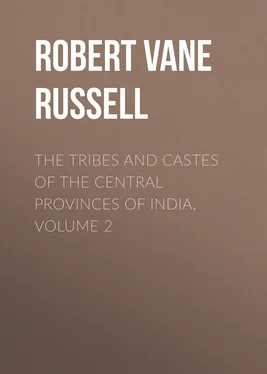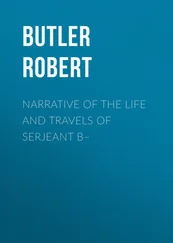Robert Vane Russell - The Tribes and Castes of the Central Provinces of India, Volume 2
Здесь есть возможность читать онлайн «Robert Vane Russell - The Tribes and Castes of the Central Provinces of India, Volume 2» — ознакомительный отрывок электронной книги совершенно бесплатно, а после прочтения отрывка купить полную версию. В некоторых случаях можно слушать аудио, скачать через торрент в формате fb2 и присутствует краткое содержание. Жанр: foreign_prose, История, foreign_edu, foreign_antique, на английском языке. Описание произведения, (предисловие) а так же отзывы посетителей доступны на портале библиотеки ЛибКат.
- Название:The Tribes and Castes of the Central Provinces of India, Volume 2
- Автор:
- Жанр:
- Год:неизвестен
- ISBN:нет данных
- Рейтинг книги:4 / 5. Голосов: 1
-
Избранное:Добавить в избранное
- Отзывы:
-
Ваша оценка:
- 80
- 1
- 2
- 3
- 4
- 5
The Tribes and Castes of the Central Provinces of India, Volume 2: краткое содержание, описание и аннотация
Предлагаем к чтению аннотацию, описание, краткое содержание или предисловие (зависит от того, что написал сам автор книги «The Tribes and Castes of the Central Provinces of India, Volume 2»). Если вы не нашли необходимую информацию о книге — напишите в комментариях, мы постараемся отыскать её.
The Tribes and Castes of the Central Provinces of India, Volume 2 — читать онлайн ознакомительный отрывок
Ниже представлен текст книги, разбитый по страницам. Система сохранения места последней прочитанной страницы, позволяет с удобством читать онлайн бесплатно книгу «The Tribes and Castes of the Central Provinces of India, Volume 2», без необходимости каждый раз заново искать на чём Вы остановились. Поставьте закладку, и сможете в любой момент перейти на страницу, на которой закончили чтение.
Интервал:
Закладка:
2. Marriage customs.
It is essential that a girl should be married before adolescence, as it is said that when the signs of puberty appear in her before wedlock her parents commit a crime equivalent to the shedding of human blood. The father of the boy looks for a bride, and after dropping hints to the girl’s family to see if his proposal is acceptable, he sends some female relatives or friends to discuss the marriage. Before the wedding the boy is presented with a chhāp or ring of gold or silver with a small cup-like attachment. A mehar or dowry must be given to the bride, the amount of which is not below Rs. 50 or above Rs. 250. The bride’s parents give her cooking vessels, bedding and a bedstead. After the wedding, the couple are seated on a cot while the women sing songs, and they see each other’s face reflected in a mirror. The procession returns after a stay of four days, and is received by the women of the bridegroom’s family with some humorous ceremonies bearing on the nature of marriage. A feast called Tāmm Walīma follows, and the couple are shut up together in an inner room, even though they may be under age. The marriage includes some Hindu customs, such as the erection of the pandal or shed, rubbing the couple with turmeric and oil, and the tying on of kankans or wrist-bands. A girl going wrong before marriage may be wedded with full rites so long as she has not conceived, but after conception until her child is born she cannot go through the ceremony at all. After the birth of the child she may be married simply with the rite for widows. She retains the child, but it has no claim to succeed to her husband’s property. A widow may marry again after an interval of forty days from her first husband’s death, and she may wed her younger brother-in-law. Divorce is permitted at the instance of either party, and for mere disagreement. A man usually divorces his wife by vowing in the presence of two witnesses that he will in future consider intercourse with her as incestuous in the same degree as with his mother. A divorced woman has a claim to her mehar or dowry if not already paid, but forfeits it if she marries again. A man can marry the daughter of his paternal uncle. The services of a Kāzi at weddings are paid for with a fee of Rs. 1–4, and well-to-do persons also give him a pair of turbans.
3. Religion.
The Atāris are Muhammadans of the Sunnī sect. They revere the Muhammadan saints, and on the night of Shabrāt they let off fireworks in honour of their ancestors and make offerings of halwa 36 36 A preparation of raisins and other fruits and rice.
to them and place lamps and scent on their tombs. They swear by the pig and abstain from eating its flesh. The dog is considered an unclean animal and its tail, ears and tongue are especially defiling. If the hair of a dog falls on the ground they cannot pray in that place because the souls of the prophets cannot come there. To see a dog flapping its ears is a bad omen, and a person starting on a journey should postpone his departure. They esteem the spider, because they say it spread its web over the mouth of the cave where Hasan and Husain lay concealed from their enemies and thus prevented it from being searched. Some of them have Pīrs or spiritual preceptors, these being Muhammadan beggars, not necessarily celibate. The ceremony of adhesion is that a man should drink sherbet from the cup from which his preceptor has drunk. They do not observe impurity after a death nor bathe on returning from a funeral.
4. Social customs.
Liquor is of course prohibited to the Atāris as to other Muhammadans, but some of them drink it nevertheless. Some of them eat beef and others abstain. The blood of animals killed must flow before death according to the rite of halāl , but they say that fish are an exception, because when Abraham was offering up his son Ishmael and God substituted a goat, the goat bleated before it was killed, and this offended Abraham, who threw his sacrificial knife into the sea: the knife struck and killed a fish, and on this account all fish are considered to be halāl or lawful food without any further rite. The Atāris observe the Hindu law of inheritance, and some of them worship Hindu deities, as Māta the goddess of smallpox. As a rule their women are not secluded. The Atāris make missi or tooth-powder from myrobalans, cloves and cardamoms, and other constituents. This has the effect of blackening the teeth. They also sell the kunku or red powder which women rub on their foreheads, its constituents being turmeric, borax and the juice of limes. They sell scent and sometimes deal in tobacco. The scents most in demand are gulāb-pāni or rose-water and phulel or essence of tilli or sesamum. Scents are usually sold by the tola of 18 annas silver weight, 37 37 The ordinary tola is a rupee weight or two-fifths of an ounce.
and a tola of attar may vary in price from 8 annas to Rs. 80. Other scents are made from khas-khas grass, the mango, henna and musk, the bela flower, 38 38 Jasminum zambac.
the champak 39 39 Michelia champaca.
and cucumber. Scent is manufactured by distillation from the flowers boiled in water, and the drops of congealed vapour fall into sandalwood oil, which they say is the basis of all scents. Fragrant oils are also sold for rubbing on the hair, made from orange flowers, jasmine, cotton-seed and the flowers of the aonla tree. 40 40 Phyllanthus emblica.
Scent is sold in tiny circular glass bottles, and the oils in little bottles made from thin leather. The Atāris also retail the little black sticks of incense which are set up and burnt at the time of taking food and in temples, so that the smell and smoke may keep off evil spirits. When professional exorcists are called upon to clear any building, such as a hospital, supposed to be haunted by spirits or the ghosts of the dead, they commence operations by placing these sticks of incense at the entrance and setting them alight as in a temple.
Audhelia
1. Origin.
Audhelia (Audhalia).—A small hybrid caste found almost exclusively in the Bilāspur District, where they number about 1000 persons. The name is derived from the word Udharia, meaning a person with clandestine sexual intimacies. The Audhelias are a mixed caste and trace their origin from a Daharia Rājpūt ancestor, by one Bhūri Bāndi, a female slave of unknown caste. This couple is supposed to have resided in Ratanpur, the old capital of Chhattīsgarh, and the female ancestors of the Audhelias are said to have been prostitutes until they developed into a caste and began to marry among themselves. Their proper avocation at present is the rearing of pigs, while some of them are also tenants and farm-labourers. Owing to the base descent and impure occupation of the caste they are held in very low esteem, and their touch is considered to convey pollution.
2. Marriage.
The caste have at present no endogamous divisions and still admit members of other castes with the exception of the very lowest. But social gradations exist to a certain extent among the members according to the position of their male ancestors, a Daharia Audhelia, for instance, being reluctant to eat or intermarry with a Panka Audhelia. Under these circumstances it has become a rule among the Audhelias not to eat with their caste-fellows excepting their own relations. On the occasion of a caste feast, therefore, each guest prepares his own food, taking only uncooked grain from his host. At present seven gotras or exogamous divisions appear to have been formed in the caste with the names of Pachbhaiya, Chhahri, Kālkhor, Bachhāwat, Dhanāwat, Bhainsa and Limuān. The following story exists as to the origin of these gotras : There were formerly three brothers, Sahasmān, Budha and Mangal, who were Sānsis or robbers. One evening the three brothers halted in a forest and went to look for food. One brought back a buffalo-horn, another a peacock’s feather and the youngest, Mangal, brought plums. The other brothers asked Mangal to let them share his plums, to which he agreed on condition that one of the brothers should give his daughter to him in marriage. As Mangal and his brothers were of one gotra or section, and the marriage would thus involve splitting up the gotra , the brothers were doubtful whether it could be performed. They sought about for some sign to determine this difficult question, and decided that if Mangal succeeded in breaking in pieces an iron image of a cat simply by blows of his naked fist, it would be a sufficient indication that they might split up their gotra . Mangal was therefore put to the ordeal and succeeded in breaking the image, so the three brothers split up their gotra , the eldest assuming the gotra name of Bhainsa because he had found a buffalo-horn, the second that of Kālkhor, which is stated to mean peacock, and the third that of Chhahri, which at any rate does not mean a plum. The word Chhahri means either ‘shadow,’ or ‘one who washes the clothes of a woman in confinement.’ If we assume it to have the latter meaning, it may be due to the fact that Mangal had to wash the clothes of his own wife, not being able to induce a professional washerman to do so on account of the incestuous nature of the connection. As the eldest brother gave his daughter in an incestuous marriage he was also degraded, and became the ancestor of the Kanjars or prostitutes, who, it is said, to the present day do not solicit Audhelias in consideration of the consanguinity existing between them. The story itself sufficiently indicates the low and mixed descent of the Audhelias, and its real meaning may possibly be that when they first began to form a separate caste they permitted incestuous marriages on account of the paucity of their members. A curious point about the story is that the incestuous nature of the connection is not taken to be the most pressing objection to the marriage of Mangal with his own niece, but the violation of the caste rule prohibiting marriage within the same gotra . Bachhāwat and Dhanāwat are the names of sections of the Banjāra caste, and the persons of these gotras among the Audhelias are probably the descendants of illicit connections among Banjāras. The word Pachbhaiya means ‘five brothers,’ and this name possibly commemorates a polyandrous connection of some Audhelia woman. Limuān means a tortoise, which is a section of many castes. Several of the section-names are thus totemistic, and, as in other castes, some reverence is paid to the animal from whom the name is derived. At present the Audhelias forbid marriage within the same gotra and also the union of first cousins. Girls are married between five and seven years of age as their numbers are scarce, and they are engaged as early as possible. Unless weddings are arranged by exchanging girls between two families, a high bride-price, often amounting to as much as Rs. 60, is paid. No stigma is incurred, however, if a girl should remain unmarried till she arrives at adolescence, but, on the contrary, a higher price is then obtained for her. Sexual licence either before or after marriage is considered a venial offence, but a woman detected in a liaison with a man of one of the lowest castes is turned out of caste. Widow marriage and divorce are freely allowed.
Читать дальшеИнтервал:
Закладка:
Похожие книги на «The Tribes and Castes of the Central Provinces of India, Volume 2»
Представляем Вашему вниманию похожие книги на «The Tribes and Castes of the Central Provinces of India, Volume 2» списком для выбора. Мы отобрали схожую по названию и смыслу литературу в надежде предоставить читателям больше вариантов отыскать новые, интересные, ещё непрочитанные произведения.
Обсуждение, отзывы о книге «The Tribes and Castes of the Central Provinces of India, Volume 2» и просто собственные мнения читателей. Оставьте ваши комментарии, напишите, что Вы думаете о произведении, его смысле или главных героях. Укажите что конкретно понравилось, а что нет, и почему Вы так считаете.












